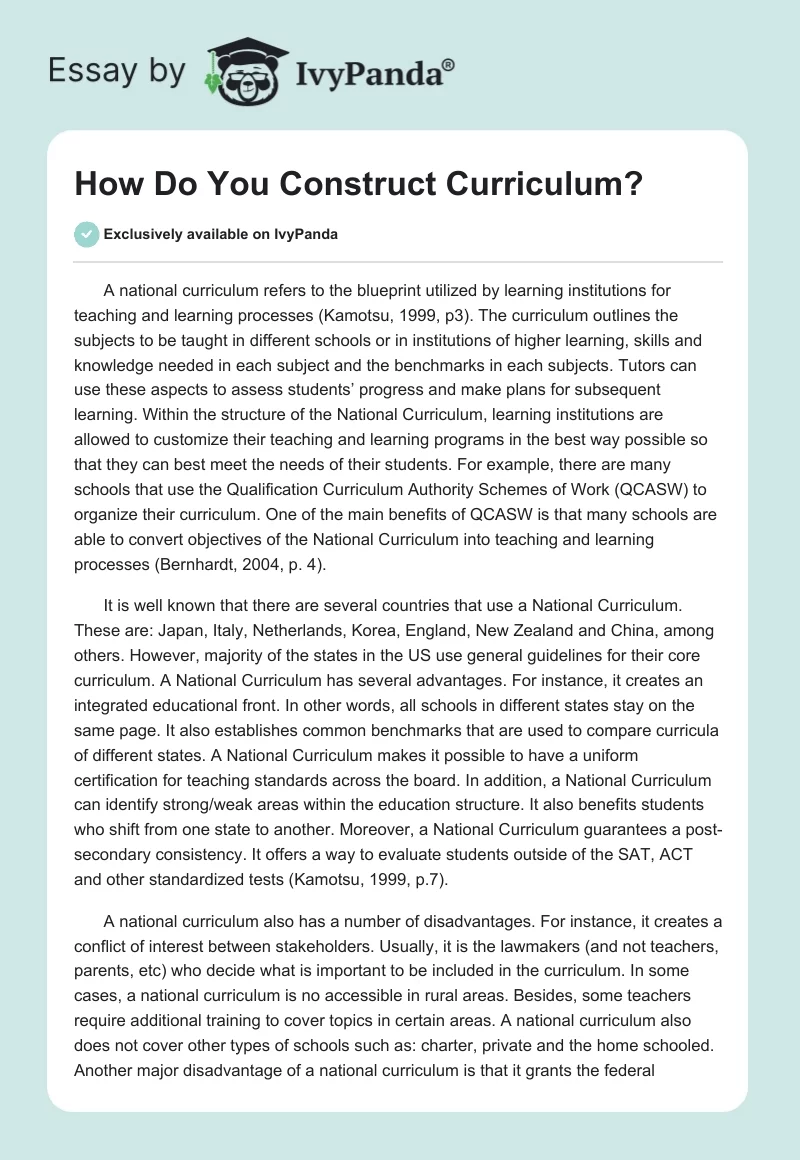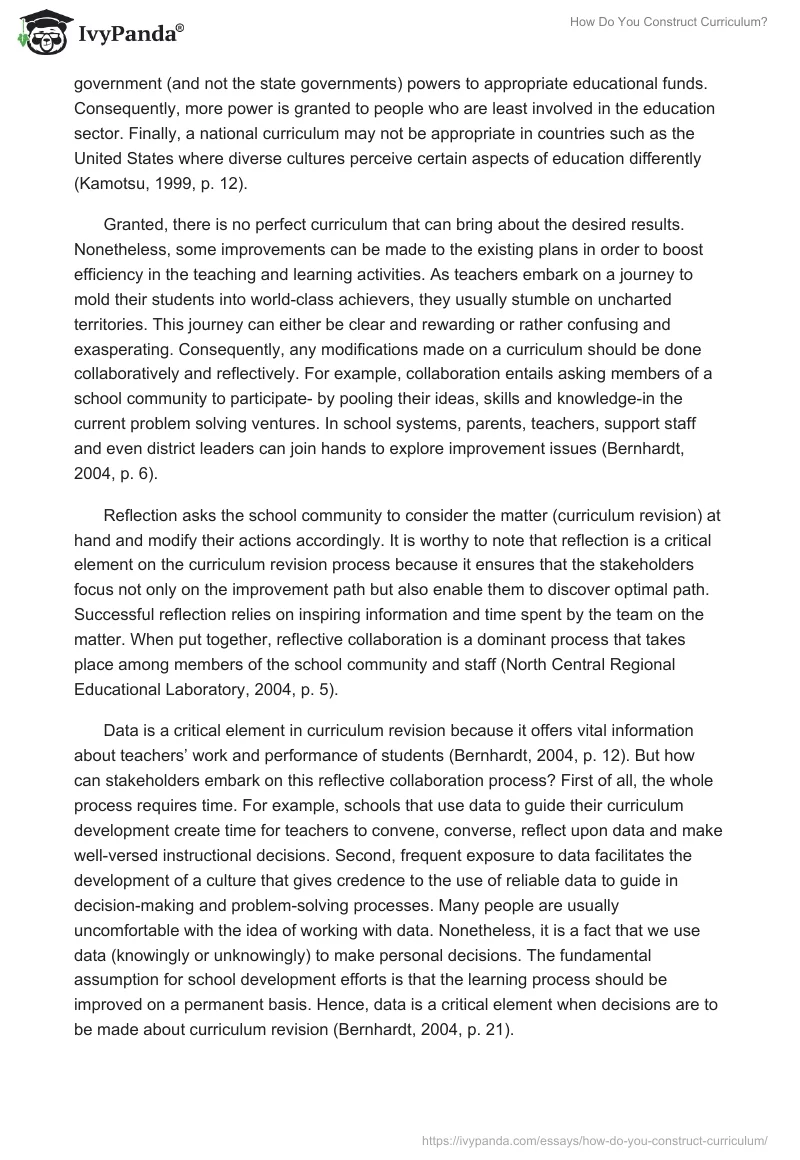A national curriculum refers to the blueprint utilized by learning institutions for teaching and learning processes (Kamotsu, 1999, p3). The curriculum outlines the subjects to be taught in different schools or in institutions of higher learning, skills and knowledge needed in each subject and the benchmarks in each subjects. Tutors can use these aspects to assess students’ progress and make plans for subsequent learning. Within the structure of the National Curriculum, learning institutions are allowed to customize their teaching and learning programs in the best way possible so that they can best meet the needs of their students. For example, there are many schools that use the Qualification Curriculum Authority Schemes of Work (QCASW) to organize their curriculum. One of the main benefits of QCASW is that many schools are able to convert objectives of the National Curriculum into teaching and learning processes (Bernhardt, 2004, p. 4).
It is well known that there are several countries that use a National Curriculum. These are: Japan, Italy, Netherlands, Korea, England, New Zealand and China, among others. However, majority of the states in the US use general guidelines for their core curriculum. A National Curriculum has several advantages. For instance, it creates an integrated educational front. In other words, all schools in different states stay on the same page. It also establishes common benchmarks that are used to compare curricula of different states. A National Curriculum makes it possible to have a uniform certification for teaching standards across the board. In addition, a National Curriculum can identify strong/weak areas within the education structure. It also benefits students who shift from one state to another. Moreover, a National Curriculum guarantees a post-secondary consistency. It offers a way to evaluate students outside of the SAT, ACT and other standardized tests (Kamotsu, 1999, p.7).
A national curriculum also has a number of disadvantages. For instance, it creates a conflict of interest between stakeholders. Usually, it is the lawmakers (and not teachers, parents, etc) who decide what is important to be included in the curriculum. In some cases, a national curriculum is no accessible in rural areas. Besides, some teachers require additional training to cover topics in certain areas. A national curriculum also does not cover other types of schools such as: charter, private and the home schooled. Another major disadvantage of a national curriculum is that it grants the federal government (and not the state governments) powers to appropriate educational funds. Consequently, more power is granted to people who are least involved in the education sector. Finally, a national curriculum may not be appropriate in countries such as the United States where diverse cultures perceive certain aspects of education differently (Kamotsu, 1999, p. 12).
Granted, there is no perfect curriculum that can bring about the desired results. Nonetheless, some improvements can be made to the existing plans in order to boost efficiency in the teaching and learning activities. As teachers embark on a journey to mold their students into world-class achievers, they usually stumble on uncharted territories. This journey can either be clear and rewarding or rather confusing and exasperating. Consequently, any modifications made on a curriculum should be done collaboratively and reflectively. For example, collaboration entails asking members of a school community to participate- by pooling their ideas, skills and knowledge-in the current problem solving ventures. In school systems, parents, teachers, support staff and even district leaders can join hands to explore improvement issues (Bernhardt, 2004, p. 6).
Reflection asks the school community to consider the matter (curriculum revision) at hand and modify their actions accordingly. It is worthy to note that reflection is a critical element on the curriculum revision process because it ensures that the stakeholders focus not only on the improvement path but also enable them to discover optimal path. Successful reflection relies on inspiring information and time spent by the team on the matter. When put together, reflective collaboration is a dominant process that takes place among members of the school community and staff (North Central Regional Educational Laboratory, 2004, p. 5).
Data is a critical element in curriculum revision because it offers vital information about teachers’ work and performance of students (Bernhardt, 2004, p. 12). But how can stakeholders embark on this reflective collaboration process? First of all, the whole process requires time. For example, schools that use data to guide their curriculum development create time for teachers to convene, converse, reflect upon data and make well-versed instructional decisions. Second, frequent exposure to data facilitates the development of a culture that gives credence to the use of reliable data to guide in decision-making and problem-solving processes. Many people are usually uncomfortable with the idea of working with data. Nonetheless, it is a fact that we use data (knowingly or unknowingly) to make personal decisions. The fundamental assumption for school development efforts is that the learning process should be improved on a permanent basis. Hence, data is a critical element when decisions are to be made about curriculum revision (Bernhardt, 2004, p. 21).
References
- Bernhardt, V. (2004). Data analysis for continuous school improvement. Larchmont, NY: Eye on Education.
- Kamotsu, S. (1999). International Education Journal.
- North Central Regional Educational Laboratory. (2004). Guide to Using Data in School Improvement Efforts: A Compilation of Knowledge from Data Retreats and Data Use at Learning Point Associates. Naperville, IL: Learning Point Associates.


